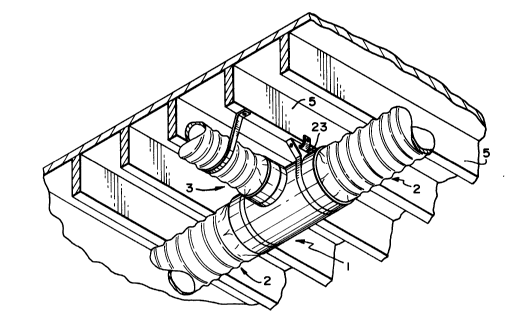Some of the information on this Web page has been provided by external sources. The Government of Canada is not responsible for the accuracy, reliability or currency of the information supplied by external sources. Users wishing to rely upon this information should consult directly with the source of the information. Content provided by external sources is not subject to official languages, privacy and accessibility requirements.
Any discrepancies in the text and image of the Claims and Abstract are due to differing posting times. Text of the Claims and Abstract are posted:
| (12) Patent: | (11) CA 2104499 |
|---|---|
| (54) English Title: | INSULATED FITTINGS FOR FLEXIBLE AIR DUCTS |
| (54) French Title: | RACCORDS ISOLES POUR CONDUITS D'AIR SOUPLE |
| Status: | Deemed expired |
| (51) International Patent Classification (IPC): |
|
|---|---|
| (72) Inventors : |
|
| (73) Owners : |
|
| (71) Applicants : |
|
| (74) Agent: | OSLER, HOSKIN & HARCOURT LLP |
| (74) Associate agent: | |
| (45) Issued: | 1996-07-16 |
| (22) Filed Date: | 1993-08-20 |
| (41) Open to Public Inspection: | 1995-02-21 |
| Examination requested: | 1993-10-15 |
| Availability of licence: | N/A |
| (25) Language of filing: | English |
| Patent Cooperation Treaty (PCT): | No |
|---|
| (30) Application Priority Data: | None |
|---|
An insulated fitting for a flexible air duct wherein
the fitting has a collar for dressing the end of the flexible
air duct coupled to the fitting. The fitting can be a tee,
wherein the collar is connected to a retaining ring rotatably
mounted to the main conduit of the tee so that the angular
position of the tee can be varied depending upon the desired
direction of the branch conduit of the tee. The retaining
ring has a base portion for securing the T-fitting to a
supporting surface. The fitting can also be a wye and a
reducer.
Note: Claims are shown in the official language in which they were submitted.
Note: Descriptions are shown in the official language in which they were submitted.

For a clearer understanding of the status of the application/patent presented on this page, the site Disclaimer , as well as the definitions for Patent , Administrative Status , Maintenance Fee and Payment History should be consulted.
| Title | Date |
|---|---|
| Forecasted Issue Date | 1996-07-16 |
| (22) Filed | 1993-08-20 |
| Examination Requested | 1993-10-15 |
| (41) Open to Public Inspection | 1995-02-21 |
| (45) Issued | 1996-07-16 |
| Deemed Expired | 1998-08-20 |
There is no abandonment history.
| Fee Type | Anniversary Year | Due Date | Amount Paid | Paid Date |
|---|---|---|---|---|
| Application Fee | $0.00 | 1993-08-20 | ||
| Maintenance Fee - Application - New Act | 2 | 1995-08-21 | $50.00 | 1995-08-16 |
| Maintenance Fee - Patent - New Act | 3 | 1996-08-20 | $50.00 | 1996-08-19 |
Note: Records showing the ownership history in alphabetical order.
| Current Owners on Record |
|---|
| ROSZIN, JOSEPH M. |
| Past Owners on Record |
|---|
| None |